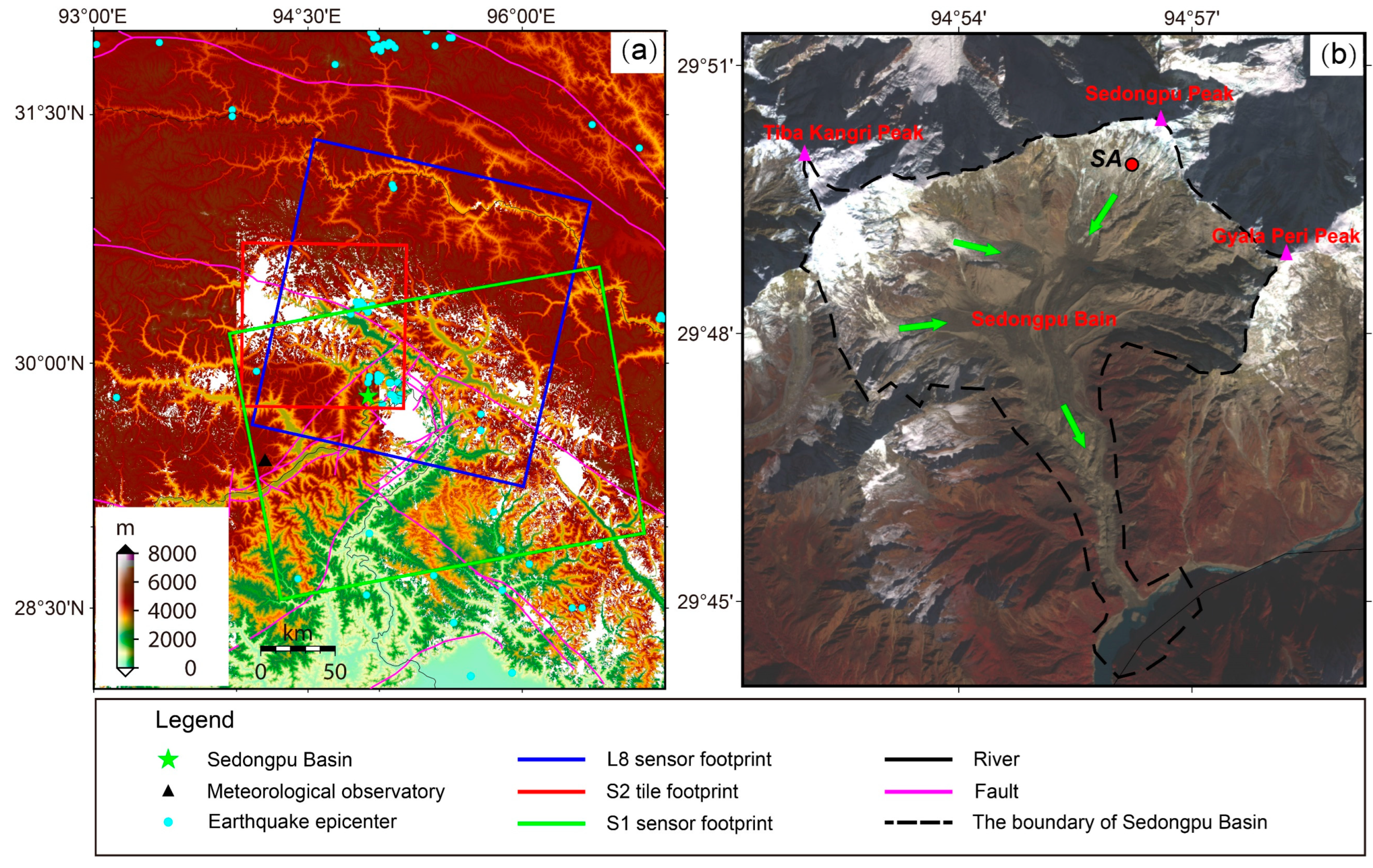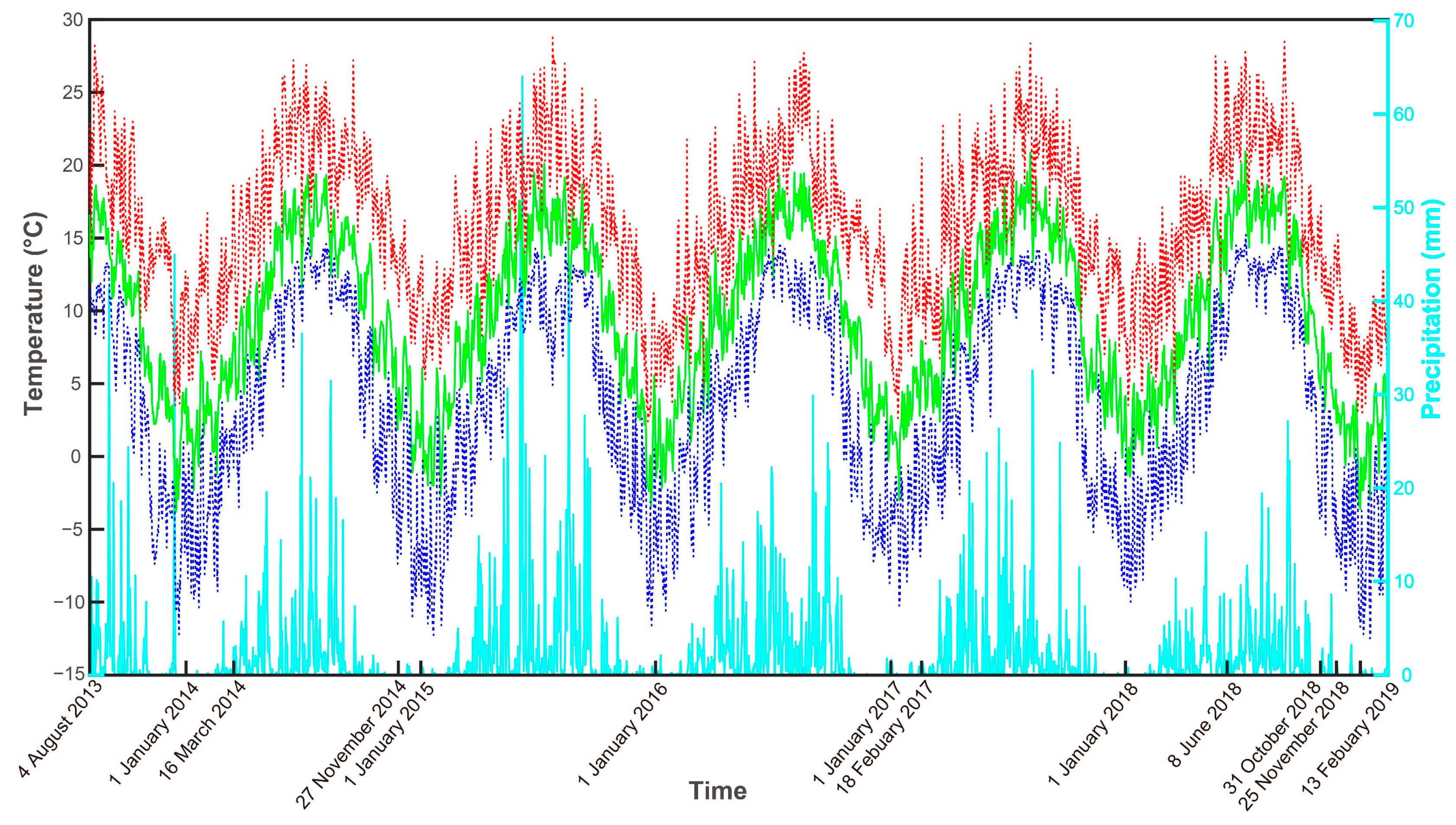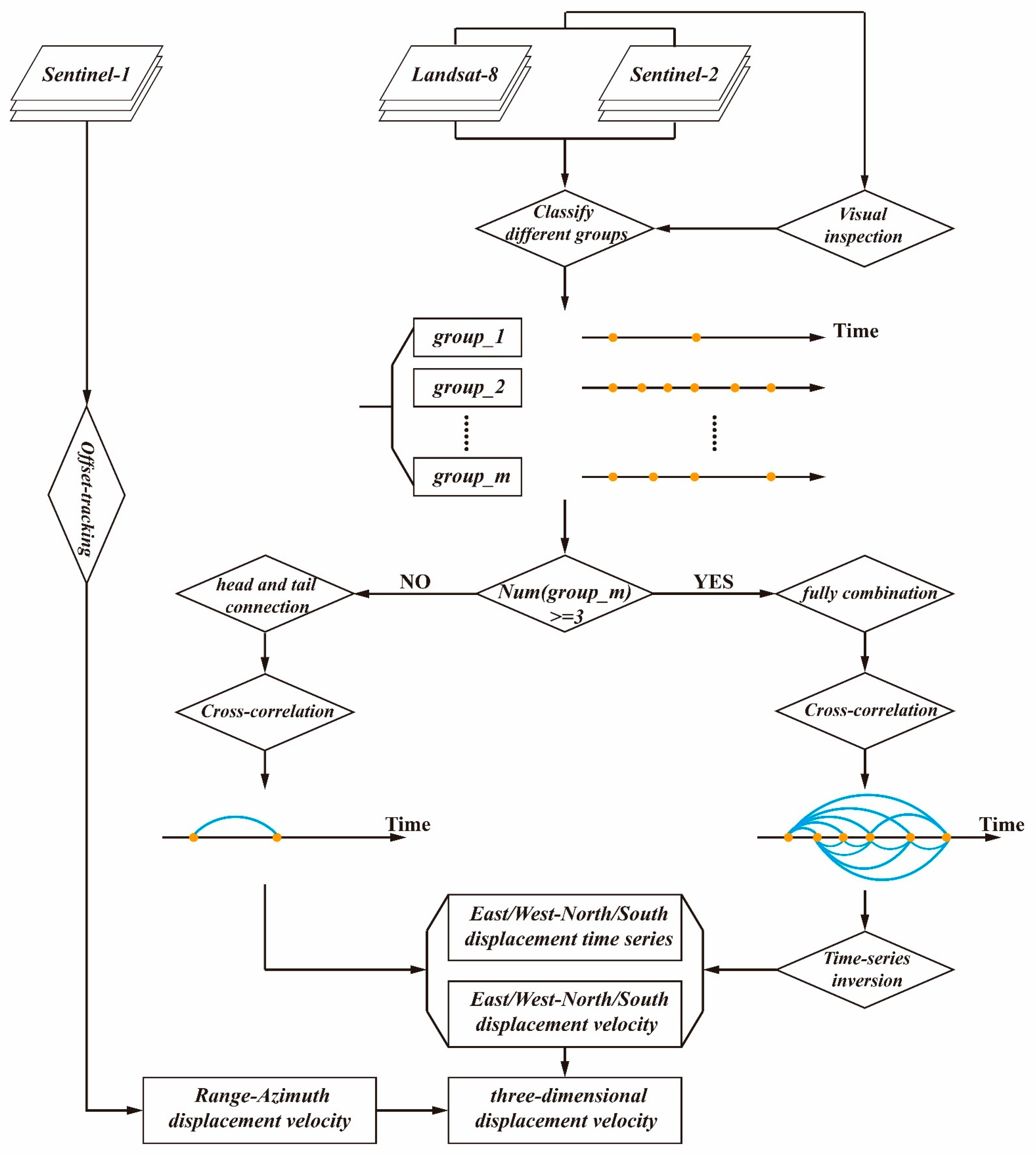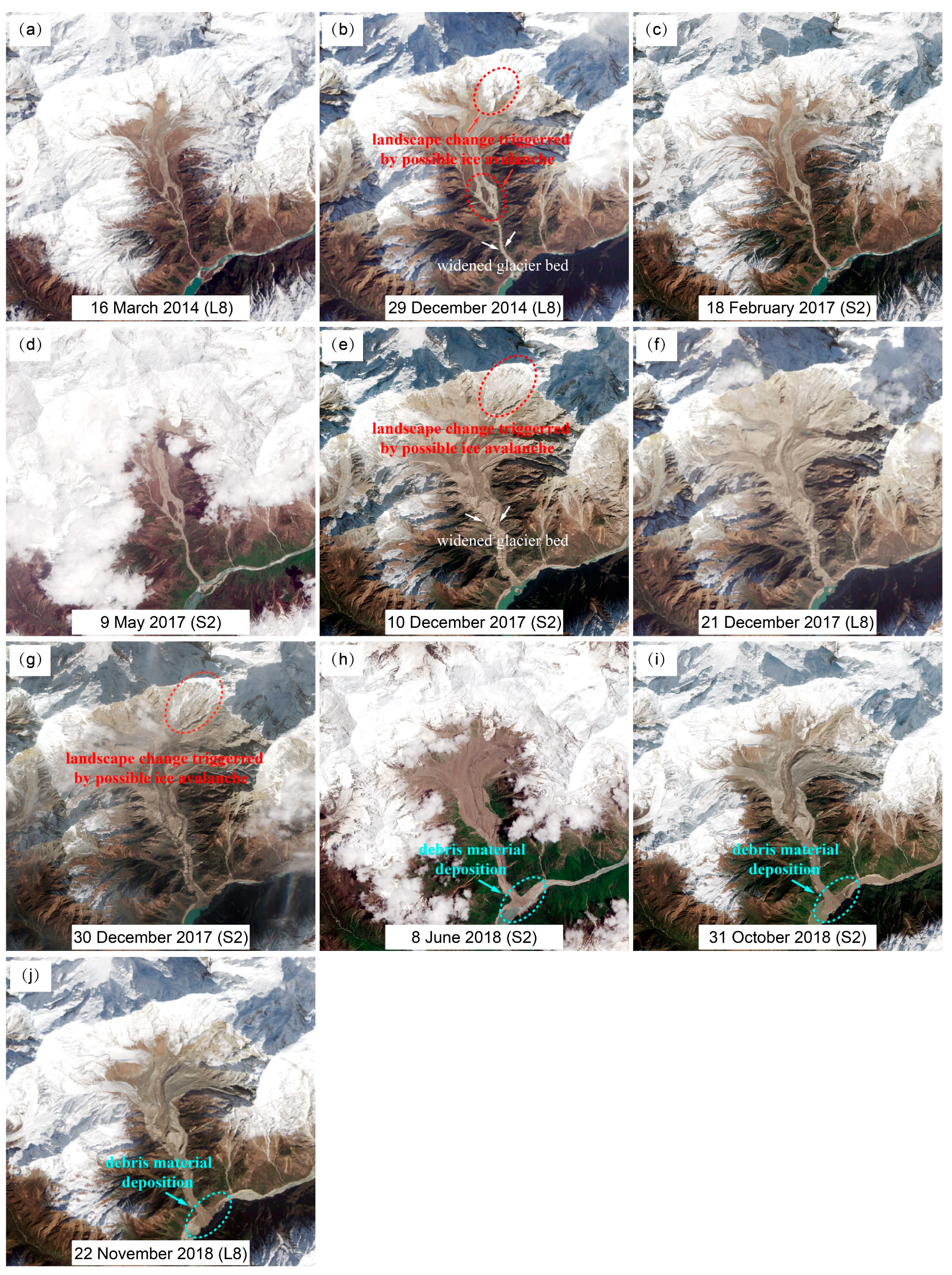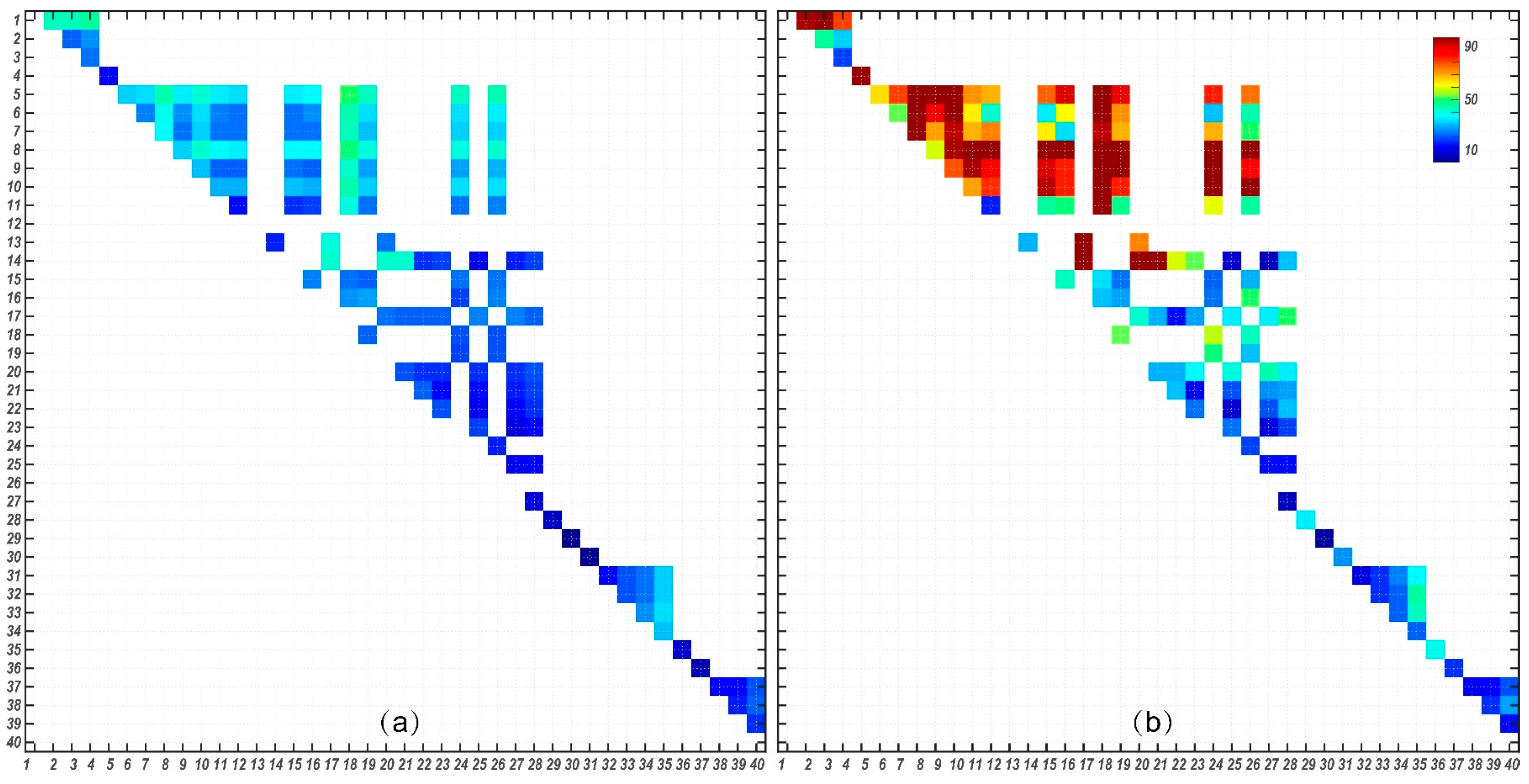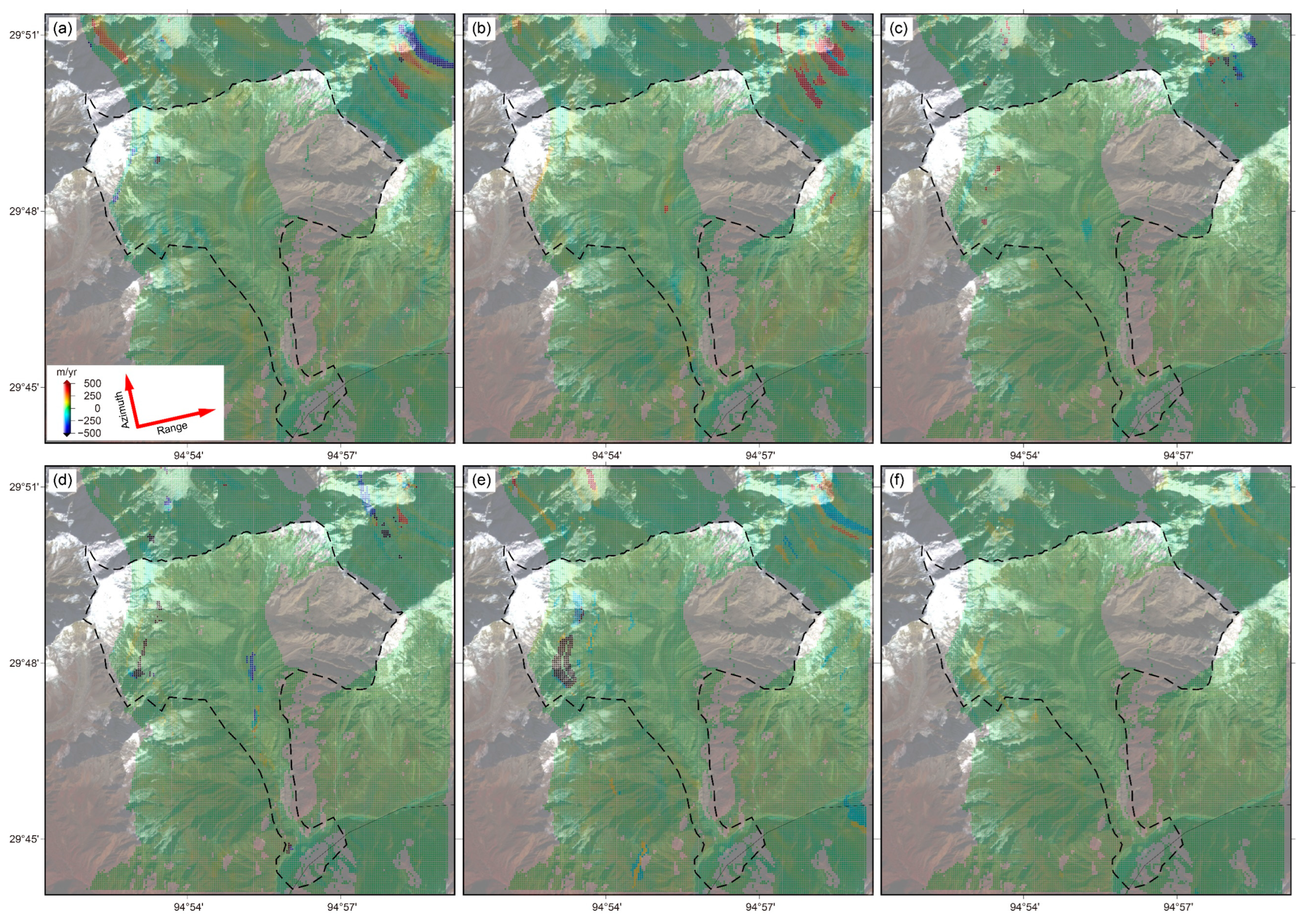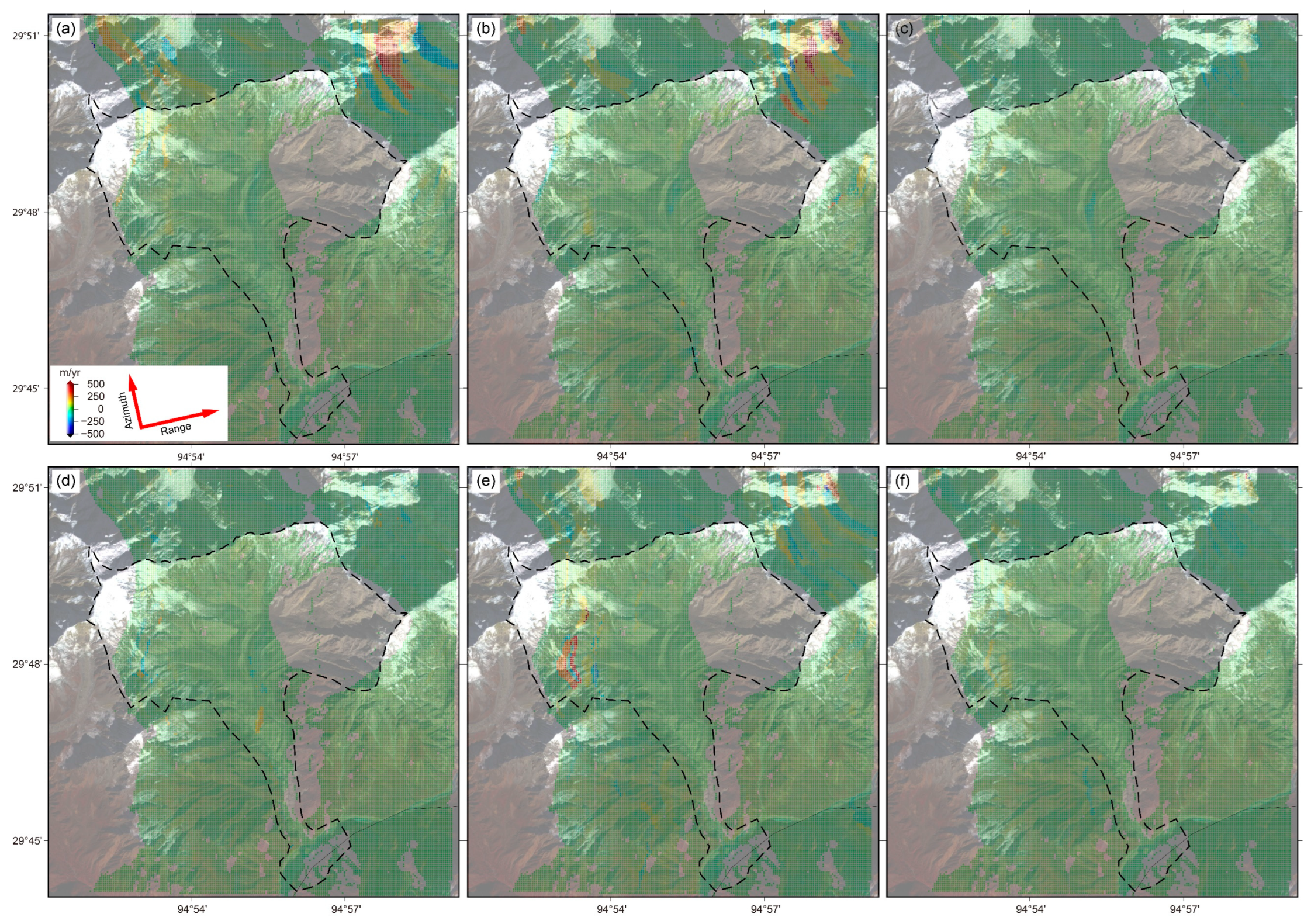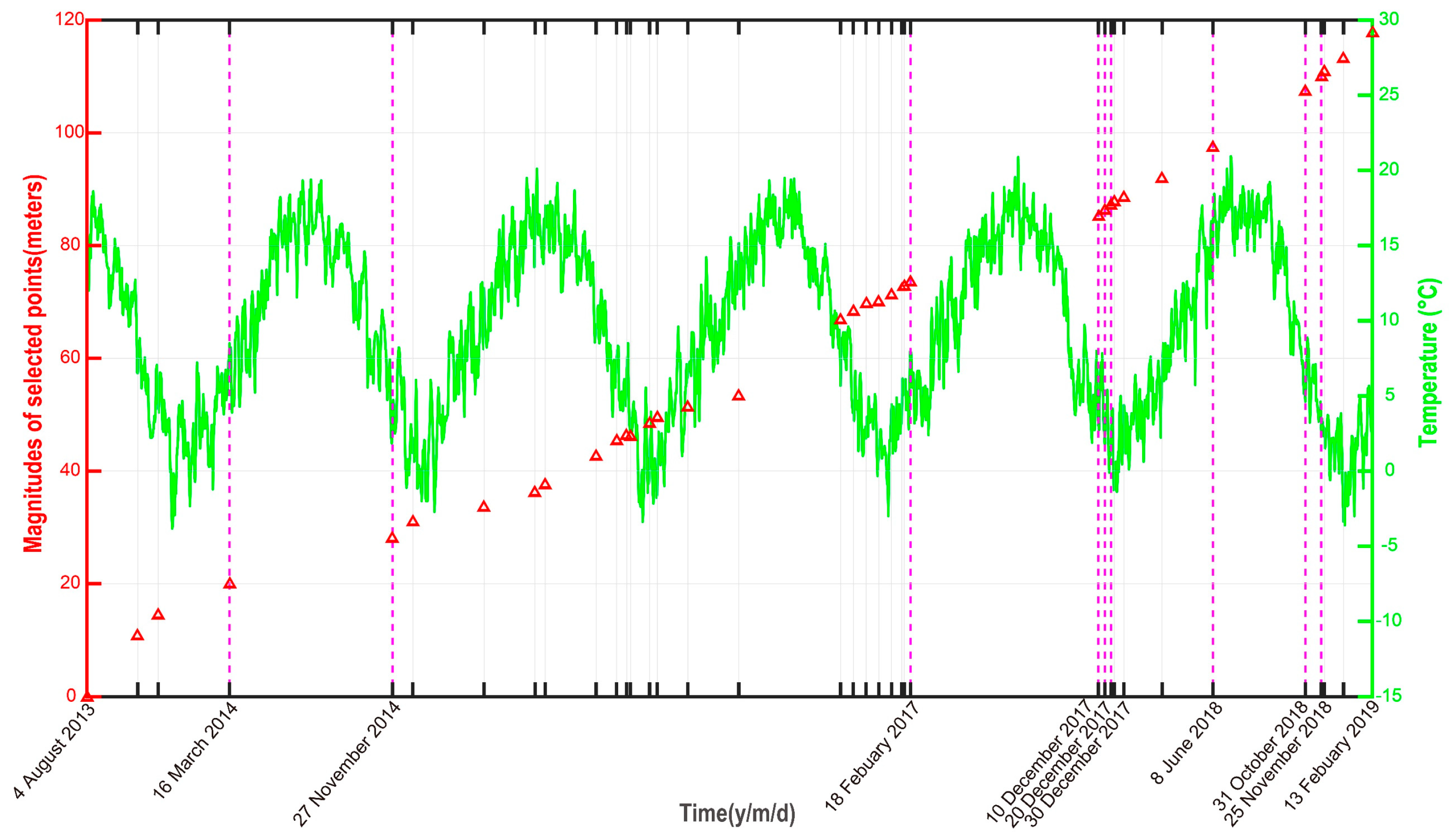Author Contributions
Conceptualization, C.D. and G.F.; methodology, C.D.; software, C.D. and Z.X.; validation, C.D., G.F. and L.Z.; formal analysis, Q.S.; investigation, C.D.; resources, Q.S.; data curation, C.D.; writing—original draft preparation, C.D.; writing—review and editing, G.F. and L.Z.; visualization, C.D.; supervision, M.L.; project administration, Q.S.; funding acquisition, C.D. All authors have read and agreed to the published version of the manuscript.
Figure 1.
The physical geography of the Sedongpu Basin. (a) The regional topography and the image footprints of the study area, with the identification of the local geological faults and historical earthquakes. (b) The geographical environment of Sedongpu Basin was revealed with the false color composite map of Sentinel-2 (S2) NIR/Red/Blue bands acquired on 10 December 2017. The green arrows denote the potential flow direction of Sedongpu Glacier.
Figure 1.
The physical geography of the Sedongpu Basin. (a) The regional topography and the image footprints of the study area, with the identification of the local geological faults and historical earthquakes. (b) The geographical environment of Sedongpu Basin was revealed with the false color composite map of Sentinel-2 (S2) NIR/Red/Blue bands acquired on 10 December 2017. The green arrows denote the potential flow direction of Sedongpu Glacier.
Figure 2.
The daily precipitation of Sedongpu Basin was downloaded from Giovanni, and the daily maximum (dotted red line), average (solid green line), and minimum (dotted blue line) air temperature was derived from a meteorological observation station located in Nyingchi County with an elevation of approximately 3000 m.
Figure 2.
The daily precipitation of Sedongpu Basin was downloaded from Giovanni, and the daily maximum (dotted red line), average (solid green line), and minimum (dotted blue line) air temperature was derived from a meteorological observation station located in Nyingchi County with an elevation of approximately 3000 m.
Figure 3.
Flowchart of the methodology proposed in this study.
Figure 3.
Flowchart of the methodology proposed in this study.
Figure 4.
The RGB real-colored combined time-series optical images of L8 and S2, in which the obvious ground geomorphic changes that may have been triggered by the ice-rock avalanches, debris flow events, and other glacial instability were emphatically highlighted. The subfigures (a–j) denote the optical images acquired on 16 March 2014 (L8), 29 December 2014 (L8), 18 February 2017 (S2), 9 May 2017 (S2), 10 December 2017 (S2), 21 December 2017 (L8), 30 December 2017 (S2), 8 June 2018 (S2), 31 October 2018 (S2), 22 November 2018 (L8), respectively.
Figure 4.
The RGB real-colored combined time-series optical images of L8 and S2, in which the obvious ground geomorphic changes that may have been triggered by the ice-rock avalanches, debris flow events, and other glacial instability were emphatically highlighted. The subfigures (a–j) denote the optical images acquired on 16 March 2014 (L8), 29 December 2014 (L8), 18 February 2017 (S2), 9 May 2017 (S2), 10 December 2017 (S2), 21 December 2017 (L8), 30 December 2017 (S2), 8 June 2018 (S2), 31 October 2018 (S2), 22 November 2018 (L8), respectively.
Figure 5.
(
a) Standard deviations (STD) in the stable area of each correlation pair in different groups after the general noise reduction and time-series inversion. (
b) Improvement of STD in the stable area of each correlation pair in comparison to the raw correlation pairs. The number labels of the horizontal axis and vertical axis denote the optical image acquisition sequence (see
Table 2) in chronological order.
Figure 5.
(
a) Standard deviations (STD) in the stable area of each correlation pair in different groups after the general noise reduction and time-series inversion. (
b) Improvement of STD in the stable area of each correlation pair in comparison to the raw correlation pairs. The number labels of the horizontal axis and vertical axis denote the optical image acquisition sequence (see
Table 2) in chronological order.
Figure 6.
The surface horizontal displacement velocity (m/yr) of active glaciers in Sedongpu Basin for the optical image groups with different time coverage. The subfigures (a–j) denote the normalized horizontal displacement velocities of Group_1 (4 August 2013–16 March 2014), Group_1_2 (16 March 2014–27 November 2014), Group_2 (27 November 2014–18 February 2017), Group_2_3 (18 February 2017–10 December 2017), Group_3 (10 December 2017–20 December 2017), Group_3_4 (20 December 2017–30 December 2017), Group_4 (30 December 2017–8 June 2018), Group_4_5 (8 June 2018–31 October 2018), Group_5_6 (31 October 2018–25 November 2018), and Group_6 (25 November 2018–13 February 2019), respectively.
Figure 6.
The surface horizontal displacement velocity (m/yr) of active glaciers in Sedongpu Basin for the optical image groups with different time coverage. The subfigures (a–j) denote the normalized horizontal displacement velocities of Group_1 (4 August 2013–16 March 2014), Group_1_2 (16 March 2014–27 November 2014), Group_2 (27 November 2014–18 February 2017), Group_2_3 (18 February 2017–10 December 2017), Group_3 (10 December 2017–20 December 2017), Group_3_4 (20 December 2017–30 December 2017), Group_4 (30 December 2017–8 June 2018), Group_4_5 (8 June 2018–31 October 2018), Group_5_6 (31 October 2018–25 November 2018), and Group_6 (25 November 2018–13 February 2019), respectively.
Figure 7.
The azimuth-oriented displacement velocity (cm/day) of active glaciers in Sedongpu Basin for the S1A SAR image groups with different time coverage, in which the subfigure (a) denotes the Group_3′ (5 December 2017–17 December 2017), the subfigure (b) denotes the Group_3′_4′ (17 December 2017–29 December 2017), the subfigure (c) denotes the Group_4′ (29 December 2017–3 June 2018), the subfigure (d) denotes the Group_4′_5′ (3 June 2018–25 October 2018), the subfigure (e) denotes the Group_5′_6′ (25 October 2018–30 November 2018), and the subfigure (f) denotes the Group_6′ (30 November 2018–10 February 2019), respectively. Measurements are positive toward the SAR sensor heading direction and negative toward the opposite direction.
Figure 7.
The azimuth-oriented displacement velocity (cm/day) of active glaciers in Sedongpu Basin for the S1A SAR image groups with different time coverage, in which the subfigure (a) denotes the Group_3′ (5 December 2017–17 December 2017), the subfigure (b) denotes the Group_3′_4′ (17 December 2017–29 December 2017), the subfigure (c) denotes the Group_4′ (29 December 2017–3 June 2018), the subfigure (d) denotes the Group_4′_5′ (3 June 2018–25 October 2018), the subfigure (e) denotes the Group_5′_6′ (25 October 2018–30 November 2018), and the subfigure (f) denotes the Group_6′ (30 November 2018–10 February 2019), respectively. Measurements are positive toward the SAR sensor heading direction and negative toward the opposite direction.
Figure 8.
The range-oriented displacement velocity (cm/day) of active glaciers in Sedongpu Basin for the S1A SAR image groups with different time coverage, in which the subfigure (a) denotes the Group_3′ (5 December 2017–17 December 2017), the subfigure (b) denotes the Group_3′_4′ (17 December 2017–29 December 2017), the subfigure (c) denotes the Group_4′ (29 December 2017–3 June 2018), the subfigure (d) denotes the Group_4′_5′ (3 June 2018–25 October 2018), the subfigure (e) denotes the Group_5′_6′ (25 October 2018–30 November 2018), and the subfigure (f) denotes the Group_6′ (30 November 2018–10 February 2019), respectively. Measurements are positive toward the radar pulse emission or range direction and negative toward the opposite direction.
Figure 8.
The range-oriented displacement velocity (cm/day) of active glaciers in Sedongpu Basin for the S1A SAR image groups with different time coverage, in which the subfigure (a) denotes the Group_3′ (5 December 2017–17 December 2017), the subfigure (b) denotes the Group_3′_4′ (17 December 2017–29 December 2017), the subfigure (c) denotes the Group_4′ (29 December 2017–3 June 2018), the subfigure (d) denotes the Group_4′_5′ (3 June 2018–25 October 2018), the subfigure (e) denotes the Group_5′_6′ (25 October 2018–30 November 2018), and the subfigure (f) denotes the Group_6′ (30 November 2018–10 February 2019), respectively. Measurements are positive toward the radar pulse emission or range direction and negative toward the opposite direction.
Figure 9.
The three-dimensional (3D) displacement velocity (cm/day) fields inverted from the optical Group_3 (10 December 2017–20 December 2017) and SAR Group_3′ (5 December 2017–17 December 2017) observations. (a) E/W oriented velocity fields; (b) N/S oriented velocity fields; and (c) vertical oriented velocity fields.
Figure 9.
The three-dimensional (3D) displacement velocity (cm/day) fields inverted from the optical Group_3 (10 December 2017–20 December 2017) and SAR Group_3′ (5 December 2017–17 December 2017) observations. (a) E/W oriented velocity fields; (b) N/S oriented velocity fields; and (c) vertical oriented velocity fields.
Figure 10.
The 3D displacement velocity (cm/day) fields inverted from the optical Group_3_4 (20 December 2017–30 December 2017) and SAR Group_3′_4′ (17 December 2017–29 December 2017) observations. (a) E/W oriented velocity fields; (b) N/S oriented velocity fields; and (c) vertically oriented velocity fields.
Figure 10.
The 3D displacement velocity (cm/day) fields inverted from the optical Group_3_4 (20 December 2017–30 December 2017) and SAR Group_3′_4′ (17 December 2017–29 December 2017) observations. (a) E/W oriented velocity fields; (b) N/S oriented velocity fields; and (c) vertically oriented velocity fields.
Figure 11.
The relationship between the displacement time series (m) of a point SA located in the source area of Sedongpu Glacier and the daily/cumulative precipitation (mm).
Figure 11.
The relationship between the displacement time series (m) of a point SA located in the source area of Sedongpu Glacier and the daily/cumulative precipitation (mm).
Figure 12.
The relationship between the displacement time series (m) of a point SA located in the source area of Sedongpu Glacier and the temperature variations of Nyingchi, a meteorological station located 40 km away from the Sedongpu Basin.
Figure 12.
The relationship between the displacement time series (m) of a point SA located in the source area of Sedongpu Glacier and the temperature variations of Nyingchi, a meteorological station located 40 km away from the Sedongpu Basin.
Figure 13.
The relationship between the displacement time series (m) of a point SA located in the source area of Sedongpu Glacier and the earthquake events with a circle distribution distance within 100 km.
Figure 13.
The relationship between the displacement time series (m) of a point SA located in the source area of Sedongpu Glacier and the earthquake events with a circle distribution distance within 100 km.
Table 1.
The occurrence time of 8 historical debris flow and river blocking events.
Table 1.
The occurrence time of 8 historical debris flow and river blocking events.
| Situations | Image Acquisition (Year/Month/Day) |
|---|
| Glacier debris flow events | 1969–1974, 2014, 22 October 2017, 28 October 2017, 21 December 2017, January 2018, 17 October 2018, 29 October 2018 |
Table 2.
The parameter configuration for different sensors.
Table 2.
The parameter configuration for different sensors.
| Sensors | Landsat-8 (L8) | Sentinel-2 (S2) | Sentinel-1 (S1) |
|---|
| Image acquisition modes | Push-broom | Push-broom | TOPS |
| Levels | L1C | L1C | L1 |
| Bands | NIR | NIR | VV |
| Incidence Angle | / | / | 39.334° |
| Azimuth Angle | / | / | 347.372° |
| Spatial resolution (m) | 15 | 10 | 2.3 (range) × 14.1 (azimuth) |
| Image time coverage | August 2013–November 2018 | December 2015–February 2019 | December 2017–February 2019 |
| Number of images | 21 | 21 | 7 |
Table 3.
Image acquisition of L8, S2, and S1A sensors used in this study.
Table 3.
Image acquisition of L8, S2, and S1A sensors used in this study.
| Sensors | Image Acquisition (Year/Month/Day) |
|---|
| L8 | 4 August 2013, 23 October 2013, 24 November 2013, 16 March 2014, 27 November 2014, 29 December 2014, 20 April 2015, 9 July 2015, 25 July 2015, 13 October 2015, 14 November 2015, 30 November 2015, 17 January 2016, 5 March 2016, 24 May 2016, 31 October 2016, 19 January 2017, 4 February 2017, 21 December 2017, 22 January 2018, 22 November 2018 |
| S2 | 6 December 2015, 5 January 2016, 5 May 2016, 31 October 2016, 20 November 2016, 10 December 2016, 30 December 2016, 19 January 2017, 8 February 2017, 18 February 2017, 10 December 2017, 20 December 2017, 30 December 2017, 4 January 2018, 19 January 2018, 20 March 2018, 31 October 2018, 25 November 2018, 30 November 2018, 30 December 2018, 13 February 2019 |
| S1A | 5 December 2017, 17 December 2017, 29 December 2017, 3 June 2018, 25 October 2018, 30 November 2018, 10 February 2019 |
Table 4.
The specific list of image acquisition and corresponding correlation pairs for different L8 and S2 image groups.
Table 4.
The specific list of image acquisition and corresponding correlation pairs for different L8 and S2 image groups.
| Groups | Image Acquisition (Year/Month/Day [Sensors#]) | Number of Correlation Pairs |
|---|
| 1 | 4 August 2013 [L8]–23 October 2013 [L8]–24 November 2013 [L8]–16 March 2014 [L8] | 6 for L8 |
| 1→2 | 16 Marc 2014 [L8]–27 November 2014 [L8] | 1 for L8 |
| 2 | 27 November 2014 [L8]–29 December 2014 [L8]–20 April 2015 [L8]–9 July 2015 [L8]–25 July 2015 [L8]–13 October 2015 [L8]–14 November 2015 [L8]–30 November 2015 [L8]–6 December 2015 [S2]–5 January 2016 [S2]–17 January 2016 [L8]–5 March 2016 [L8]–5 March 2016 [S2]–24 May 2016 [L8]–31 October 2016 [L8]–31 October 2016 [S2]–20 November 2016 [S2]–10 December 2016 [S2]–30 December 2016 [S2]–19 January 2017 [L8]–19 January 2017 [S2]–4 February 2017 [L8]–8 February 2017 [S2]–18 February 2017 [S2] | 136 |
| 2→3 | 18 February 2017 [S2]–10 December 2017 [S2] | 1 for S2 |
| 3 | 10 December 2017 [S2]–20 December 2017 [S2] | 1 for S2 |
| 3→4 | 20 December 2017 [S2]–30 December 2017 [S2] | 1 for S2 |
| 4 | 30 December 2017 [S2]–4 January 2018 [S2]–19 January 2018 [S2]–20 March 2018 [S2]–8 June 2018 [S2] | 10 for S2 |
| 4→5 | 8 June 2018 [S2]–31 October 2018 [S2] | 1 for S2 |
| 5 | 31 October 2018 [S2] | / |
| 5→6 | 31 October 2018 [S2]–25 November 2018 [S2] | 1 for S2 |
| 6 | 35 October 2018 [S2]–30 November 2018 [S2]–30 December 2018 [S2]–13 February 2019 [S2] | 6 for S2 |
Table 5.
Parameter configuration for optical image correlation processing.
Table 5.
Parameter configuration for optical image correlation processing.
| Optical Sensors | L8 | S2 |
|---|
| Frequency correlator | Search window | Initial size (pixels) | 64 × 64 | 64 × 64 |
| Final size (pixels) | 32 × 32 | 32 × 32 |
| Steps (pixels) | 4 × 4 | 6 × 6 |
| Robust iterations | 2 | 2 |
| Frequency mask | 0.9 | 0.9 |
Table 6.
Different image groups of the S1A sensor were used in this study.
Table 6.
Different image groups of the S1A sensor were used in this study.
| Groups | Image Acquisition (Year/Month/Day [Ascending]) |
|---|
| 3′ | 5 December 2017–17 December 2017 |
| 3′→4′ | 17 December 2017–29 December 2017 |
| 4′ | 29 December 2017–3 June 2018 |
| 4′→5′ | 3 June 2018–25 October 2018 |
| 5′ | 25 October 2018 |
| 5′→6′ | 25 October 2018–30 November 2018 |
| 6′ | 30 November 2018–10 February 2019 |
Table 7.
Parameters configuration used for S1A offset-tracking processing.
Table 7.
Parameters configuration used for S1A offset-tracking processing.
| Sensors | S1A |
|---|
| Range Correlation Window Size (Pixels) | 128 |
| Azimuth Correlation Window Size (Pixels) | 128 |
| Range Search Steps (Pixels) | 5 |
| Azimuth Search Steps (Pixels) | 1 |
| Mask Threshold | 0.01 |
